BMP4002 Business Law Assessment 2 Report: UK Business Organizations
VerifiedAdded on 2023/06/10
|9
|2693
|141
Report
AI Summary
This report, prepared for a Business Law assessment, analyzes the legal context for business organizations in the UK, specifically addressing the case of IOM Solutions, a sole trader business. It begins with an introduction to business law and its relevance, followed by an overview of various types of businesses and organizations in the UK. The report delves into the legal structures of sole traders, general partnerships, partnerships, and limited liability companies (LLCs), detailing their formation, taxation, liability, and dissolution processes. It provides a comparative analysis of the advantages and disadvantages of each structure. The report concludes with recommendations for IOM Solutions regarding the most suitable business structure for expansion and growth. The document also covers relevant business laws such as employment, immigration, and consumer goods sales.
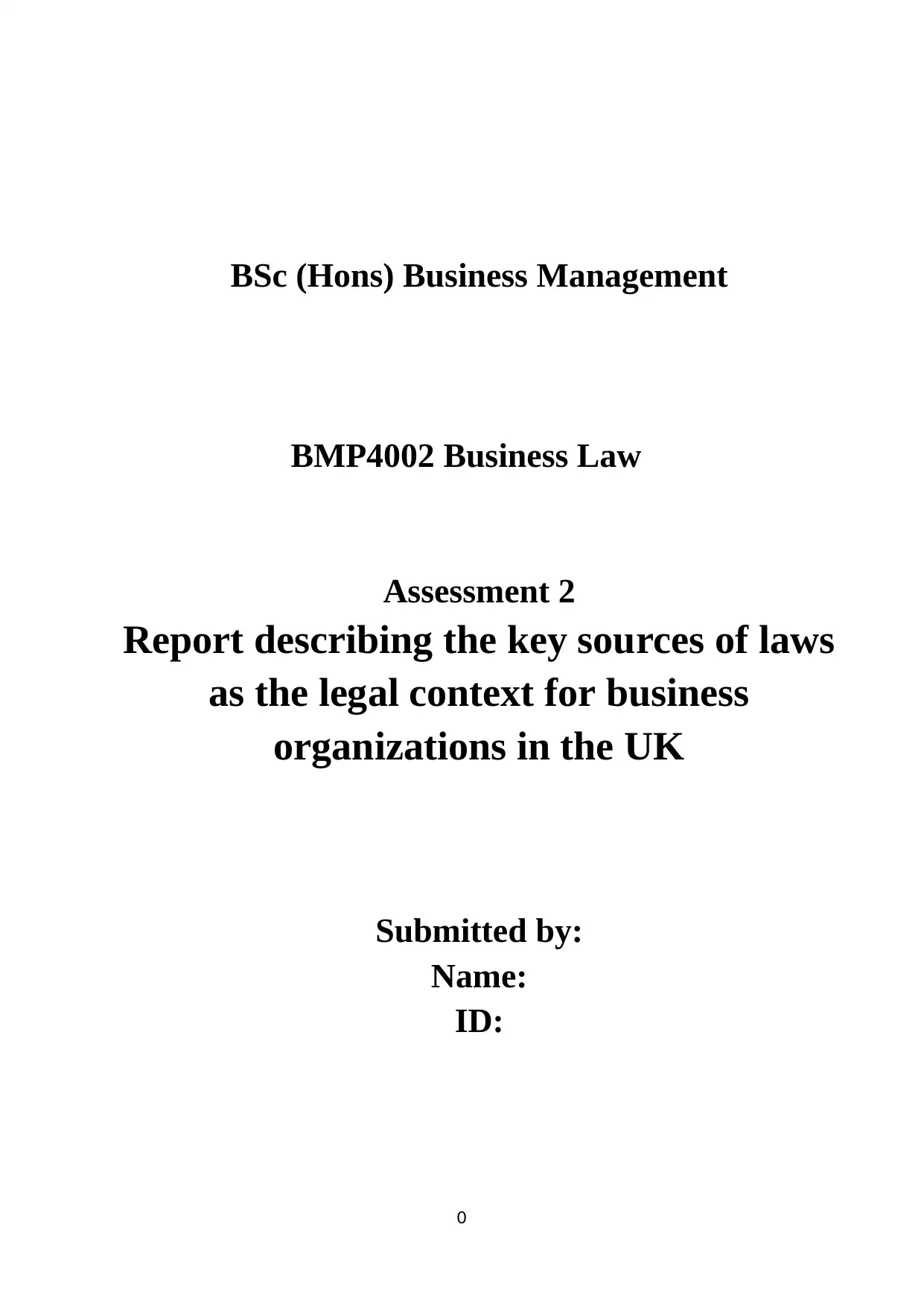
BSc (Hons) Business Management
BMP4002 Business Law
Assessment 2
Report describing the key sources of laws
as the legal context for business
organizations in the UK
Submitted by:
Name:
ID:
0
BMP4002 Business Law
Assessment 2
Report describing the key sources of laws
as the legal context for business
organizations in the UK
Submitted by:
Name:
ID:
0
Paraphrase This Document
Need a fresh take? Get an instant paraphrase of this document with our AI Paraphraser
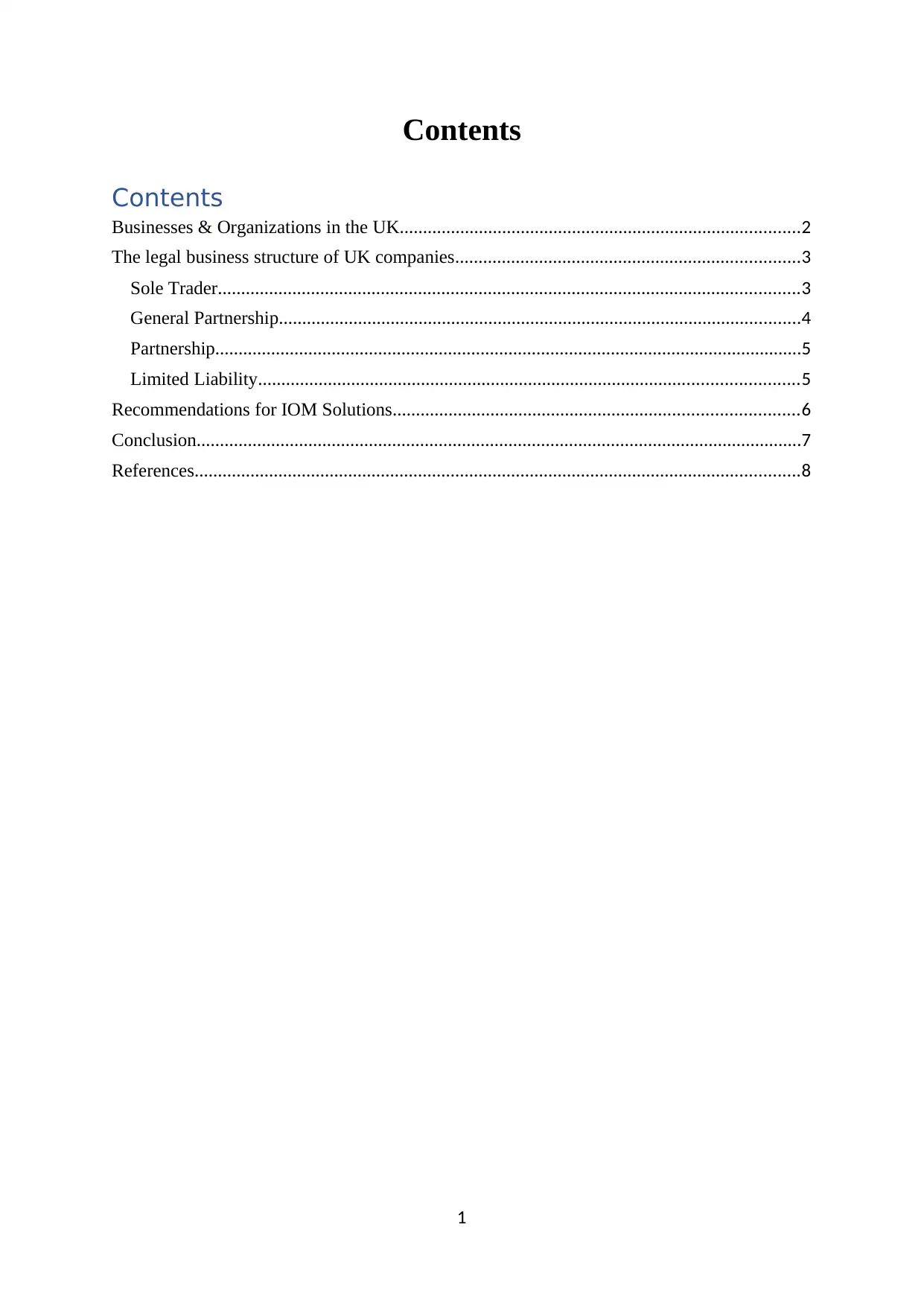
Contents
Contents
Businesses & Organizations in the UK......................................................................................2
The legal business structure of UK companies..........................................................................3
Sole Trader.............................................................................................................................3
General Partnership................................................................................................................4
Partnership..............................................................................................................................5
Limited Liability....................................................................................................................5
Recommendations for IOM Solutions.......................................................................................6
Conclusion..................................................................................................................................7
References..................................................................................................................................8
1
Contents
Businesses & Organizations in the UK......................................................................................2
The legal business structure of UK companies..........................................................................3
Sole Trader.............................................................................................................................3
General Partnership................................................................................................................4
Partnership..............................................................................................................................5
Limited Liability....................................................................................................................5
Recommendations for IOM Solutions.......................................................................................6
Conclusion..................................................................................................................................7
References..................................................................................................................................8
1
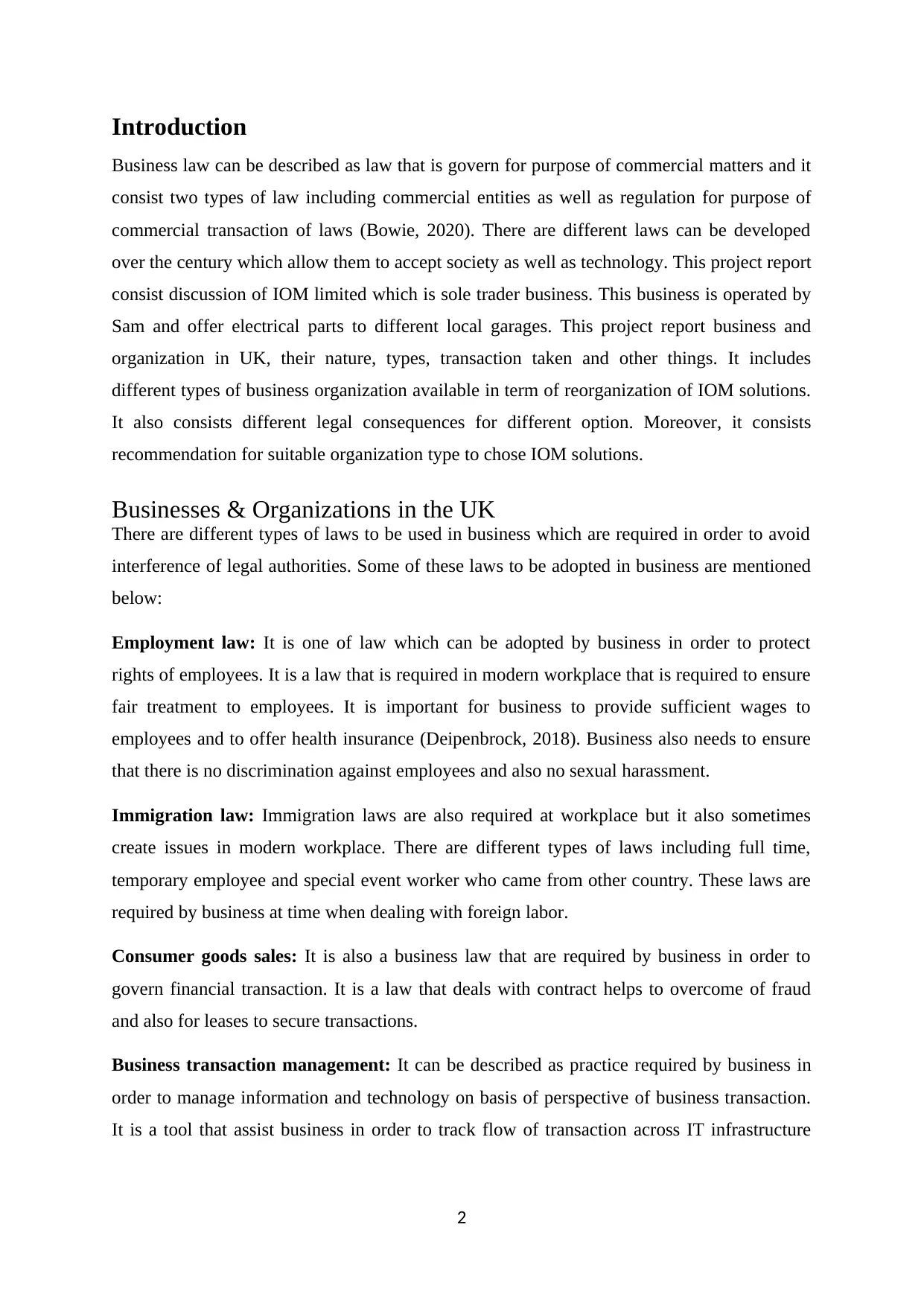
Introduction
Business law can be described as law that is govern for purpose of commercial matters and it
consist two types of law including commercial entities as well as regulation for purpose of
commercial transaction of laws (Bowie, 2020). There are different laws can be developed
over the century which allow them to accept society as well as technology. This project report
consist discussion of IOM limited which is sole trader business. This business is operated by
Sam and offer electrical parts to different local garages. This project report business and
organization in UK, their nature, types, transaction taken and other things. It includes
different types of business organization available in term of reorganization of IOM solutions.
It also consists different legal consequences for different option. Moreover, it consists
recommendation for suitable organization type to chose IOM solutions.
Businesses & Organizations in the UK
There are different types of laws to be used in business which are required in order to avoid
interference of legal authorities. Some of these laws to be adopted in business are mentioned
below:
Employment law: It is one of law which can be adopted by business in order to protect
rights of employees. It is a law that is required in modern workplace that is required to ensure
fair treatment to employees. It is important for business to provide sufficient wages to
employees and to offer health insurance (Deipenbrock, 2018). Business also needs to ensure
that there is no discrimination against employees and also no sexual harassment.
Immigration law: Immigration laws are also required at workplace but it also sometimes
create issues in modern workplace. There are different types of laws including full time,
temporary employee and special event worker who came from other country. These laws are
required by business at time when dealing with foreign labor.
Consumer goods sales: It is also a business law that are required by business in order to
govern financial transaction. It is a law that deals with contract helps to overcome of fraud
and also for leases to secure transactions.
Business transaction management: It can be described as practice required by business in
order to manage information and technology on basis of perspective of business transaction.
It is a tool that assist business in order to track flow of transaction across IT infrastructure
2
Business law can be described as law that is govern for purpose of commercial matters and it
consist two types of law including commercial entities as well as regulation for purpose of
commercial transaction of laws (Bowie, 2020). There are different laws can be developed
over the century which allow them to accept society as well as technology. This project report
consist discussion of IOM limited which is sole trader business. This business is operated by
Sam and offer electrical parts to different local garages. This project report business and
organization in UK, their nature, types, transaction taken and other things. It includes
different types of business organization available in term of reorganization of IOM solutions.
It also consists different legal consequences for different option. Moreover, it consists
recommendation for suitable organization type to chose IOM solutions.
Businesses & Organizations in the UK
There are different types of laws to be used in business which are required in order to avoid
interference of legal authorities. Some of these laws to be adopted in business are mentioned
below:
Employment law: It is one of law which can be adopted by business in order to protect
rights of employees. It is a law that is required in modern workplace that is required to ensure
fair treatment to employees. It is important for business to provide sufficient wages to
employees and to offer health insurance (Deipenbrock, 2018). Business also needs to ensure
that there is no discrimination against employees and also no sexual harassment.
Immigration law: Immigration laws are also required at workplace but it also sometimes
create issues in modern workplace. There are different types of laws including full time,
temporary employee and special event worker who came from other country. These laws are
required by business at time when dealing with foreign labor.
Consumer goods sales: It is also a business law that are required by business in order to
govern financial transaction. It is a law that deals with contract helps to overcome of fraud
and also for leases to secure transactions.
Business transaction management: It can be described as practice required by business in
order to manage information and technology on basis of perspective of business transaction.
It is a tool that assist business in order to track flow of transaction across IT infrastructure
2
⊘ This is a preview!⊘
Do you want full access?
Subscribe today to unlock all pages.

Trusted by 1+ million students worldwide
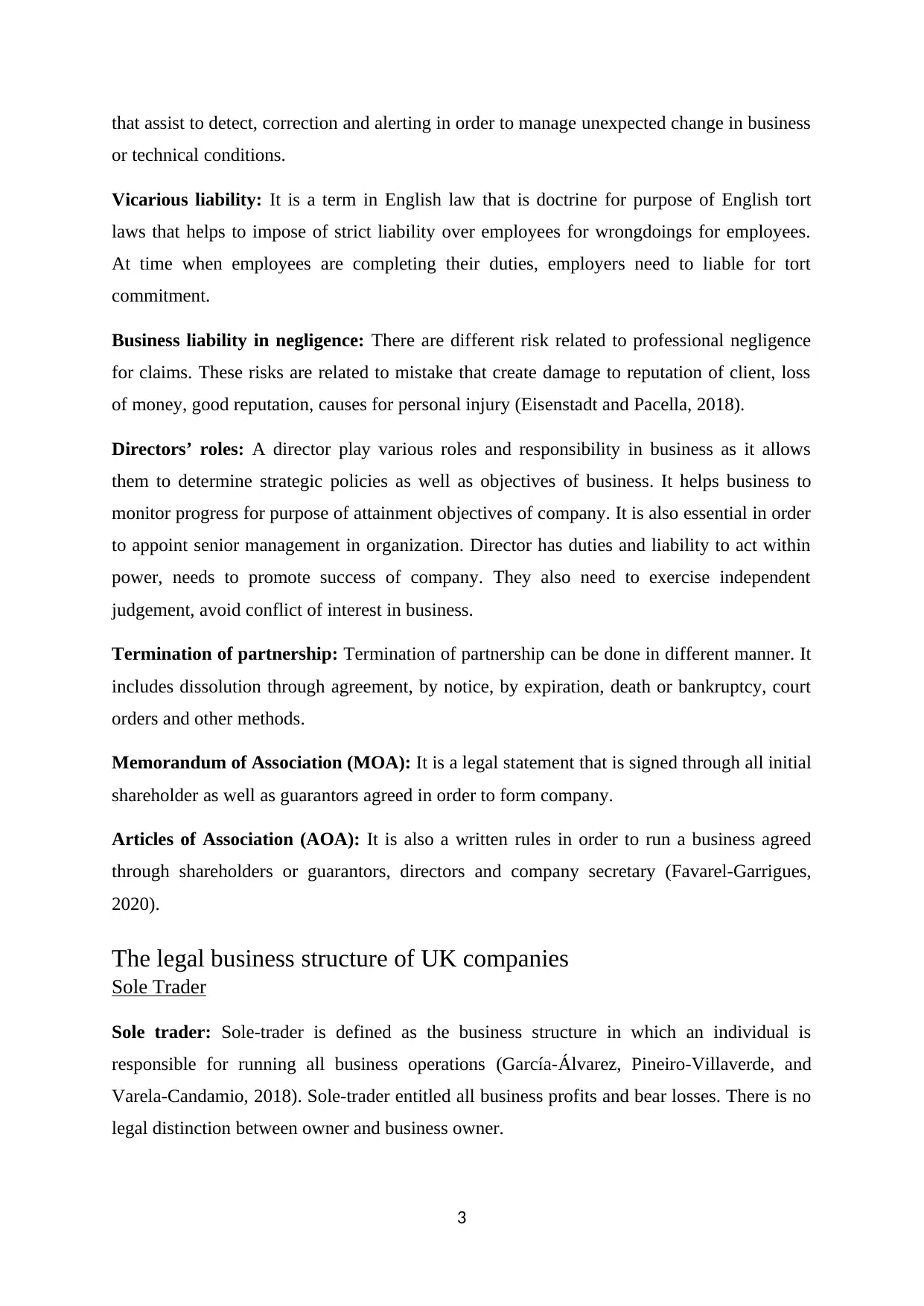
that assist to detect, correction and alerting in order to manage unexpected change in business
or technical conditions.
Vicarious liability: It is a term in English law that is doctrine for purpose of English tort
laws that helps to impose of strict liability over employees for wrongdoings for employees.
At time when employees are completing their duties, employers need to liable for tort
commitment.
Business liability in negligence: There are different risk related to professional negligence
for claims. These risks are related to mistake that create damage to reputation of client, loss
of money, good reputation, causes for personal injury (Eisenstadt and Pacella, 2018).
Directors’ roles: A director play various roles and responsibility in business as it allows
them to determine strategic policies as well as objectives of business. It helps business to
monitor progress for purpose of attainment objectives of company. It is also essential in order
to appoint senior management in organization. Director has duties and liability to act within
power, needs to promote success of company. They also need to exercise independent
judgement, avoid conflict of interest in business.
Termination of partnership: Termination of partnership can be done in different manner. It
includes dissolution through agreement, by notice, by expiration, death or bankruptcy, court
orders and other methods.
Memorandum of Association (MOA): It is a legal statement that is signed through all initial
shareholder as well as guarantors agreed in order to form company.
Articles of Association (AOA): It is also a written rules in order to run a business agreed
through shareholders or guarantors, directors and company secretary (Favarel-Garrigues,
2020).
The legal business structure of UK companies
Sole Trader
Sole trader: Sole-trader is defined as the business structure in which an individual is
responsible for running all business operations (García-Álvarez, Pineiro-Villaverde, and
Varela-Candamio, 2018). Sole-trader entitled all business profits and bear losses. There is no
legal distinction between owner and business owner.
3
or technical conditions.
Vicarious liability: It is a term in English law that is doctrine for purpose of English tort
laws that helps to impose of strict liability over employees for wrongdoings for employees.
At time when employees are completing their duties, employers need to liable for tort
commitment.
Business liability in negligence: There are different risk related to professional negligence
for claims. These risks are related to mistake that create damage to reputation of client, loss
of money, good reputation, causes for personal injury (Eisenstadt and Pacella, 2018).
Directors’ roles: A director play various roles and responsibility in business as it allows
them to determine strategic policies as well as objectives of business. It helps business to
monitor progress for purpose of attainment objectives of company. It is also essential in order
to appoint senior management in organization. Director has duties and liability to act within
power, needs to promote success of company. They also need to exercise independent
judgement, avoid conflict of interest in business.
Termination of partnership: Termination of partnership can be done in different manner. It
includes dissolution through agreement, by notice, by expiration, death or bankruptcy, court
orders and other methods.
Memorandum of Association (MOA): It is a legal statement that is signed through all initial
shareholder as well as guarantors agreed in order to form company.
Articles of Association (AOA): It is also a written rules in order to run a business agreed
through shareholders or guarantors, directors and company secretary (Favarel-Garrigues,
2020).
The legal business structure of UK companies
Sole Trader
Sole trader: Sole-trader is defined as the business structure in which an individual is
responsible for running all business operations (García-Álvarez, Pineiro-Villaverde, and
Varela-Candamio, 2018). Sole-trader entitled all business profits and bear losses. There is no
legal distinction between owner and business owner.
3
Paraphrase This Document
Need a fresh take? Get an instant paraphrase of this document with our AI Paraphraser
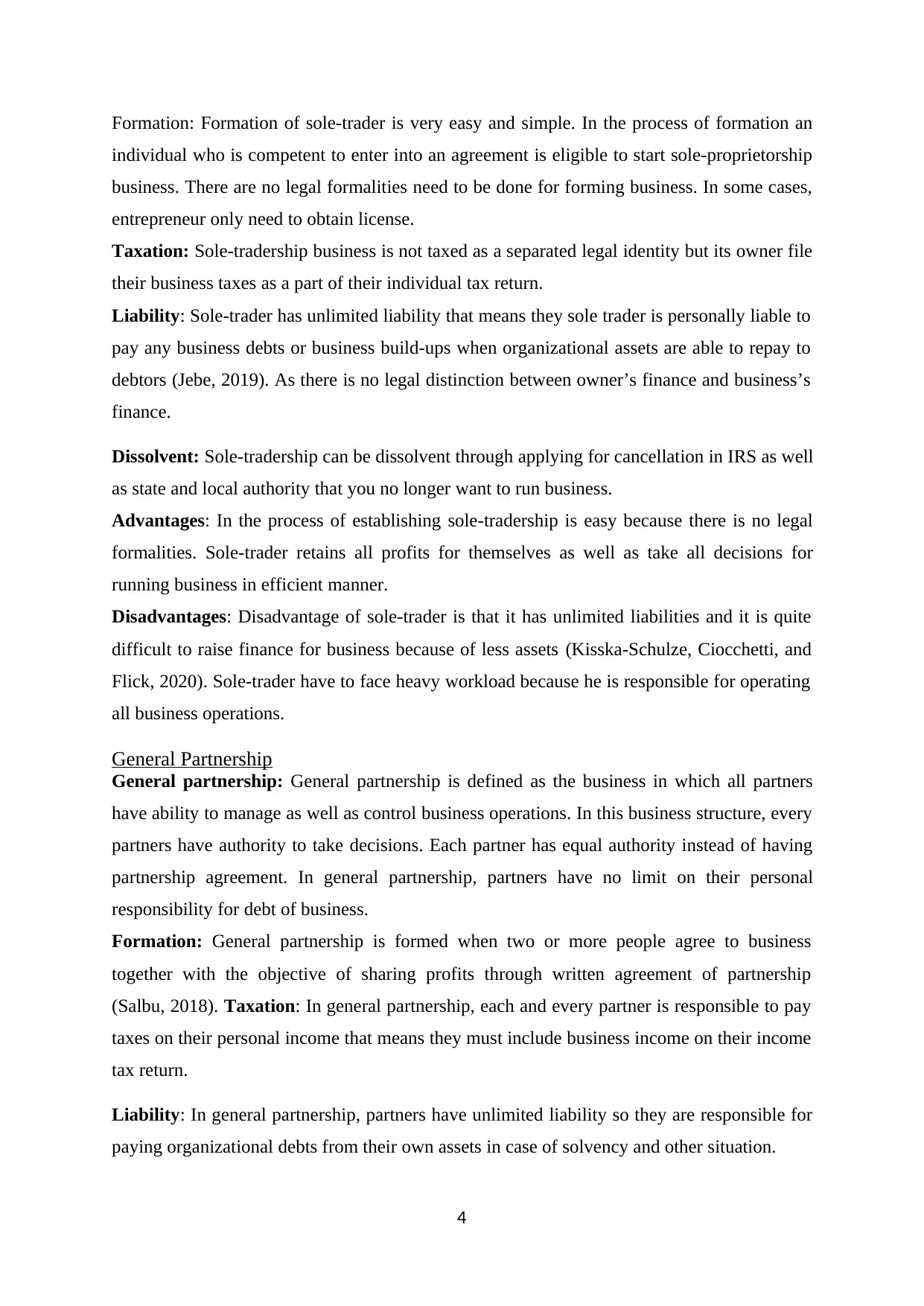
Formation: Formation of sole-trader is very easy and simple. In the process of formation an
individual who is competent to enter into an agreement is eligible to start sole-proprietorship
business. There are no legal formalities need to be done for forming business. In some cases,
entrepreneur only need to obtain license.
Taxation: Sole-tradership business is not taxed as a separated legal identity but its owner file
their business taxes as a part of their individual tax return.
Liability: Sole-trader has unlimited liability that means they sole trader is personally liable to
pay any business debts or business build-ups when organizational assets are able to repay to
debtors (Jebe, 2019). As there is no legal distinction between owner’s finance and business’s
finance.
Dissolvent: Sole-tradership can be dissolvent through applying for cancellation in IRS as well
as state and local authority that you no longer want to run business.
Advantages: In the process of establishing sole-tradership is easy because there is no legal
formalities. Sole-trader retains all profits for themselves as well as take all decisions for
running business in efficient manner.
Disadvantages: Disadvantage of sole-trader is that it has unlimited liabilities and it is quite
difficult to raise finance for business because of less assets (Kisska‐Schulze, Ciocchetti, and
Flick, 2020). Sole-trader have to face heavy workload because he is responsible for operating
all business operations.
General Partnership
General partnership: General partnership is defined as the business in which all partners
have ability to manage as well as control business operations. In this business structure, every
partners have authority to take decisions. Each partner has equal authority instead of having
partnership agreement. In general partnership, partners have no limit on their personal
responsibility for debt of business.
Formation: General partnership is formed when two or more people agree to business
together with the objective of sharing profits through written agreement of partnership
(Salbu, 2018). Taxation: In general partnership, each and every partner is responsible to pay
taxes on their personal income that means they must include business income on their income
tax return.
Liability: In general partnership, partners have unlimited liability so they are responsible for
paying organizational debts from their own assets in case of solvency and other situation.
4
individual who is competent to enter into an agreement is eligible to start sole-proprietorship
business. There are no legal formalities need to be done for forming business. In some cases,
entrepreneur only need to obtain license.
Taxation: Sole-tradership business is not taxed as a separated legal identity but its owner file
their business taxes as a part of their individual tax return.
Liability: Sole-trader has unlimited liability that means they sole trader is personally liable to
pay any business debts or business build-ups when organizational assets are able to repay to
debtors (Jebe, 2019). As there is no legal distinction between owner’s finance and business’s
finance.
Dissolvent: Sole-tradership can be dissolvent through applying for cancellation in IRS as well
as state and local authority that you no longer want to run business.
Advantages: In the process of establishing sole-tradership is easy because there is no legal
formalities. Sole-trader retains all profits for themselves as well as take all decisions for
running business in efficient manner.
Disadvantages: Disadvantage of sole-trader is that it has unlimited liabilities and it is quite
difficult to raise finance for business because of less assets (Kisska‐Schulze, Ciocchetti, and
Flick, 2020). Sole-trader have to face heavy workload because he is responsible for operating
all business operations.
General Partnership
General partnership: General partnership is defined as the business in which all partners
have ability to manage as well as control business operations. In this business structure, every
partners have authority to take decisions. Each partner has equal authority instead of having
partnership agreement. In general partnership, partners have no limit on their personal
responsibility for debt of business.
Formation: General partnership is formed when two or more people agree to business
together with the objective of sharing profits through written agreement of partnership
(Salbu, 2018). Taxation: In general partnership, each and every partner is responsible to pay
taxes on their personal income that means they must include business income on their income
tax return.
Liability: In general partnership, partners have unlimited liability so they are responsible for
paying organizational debts from their own assets in case of solvency and other situation.
4
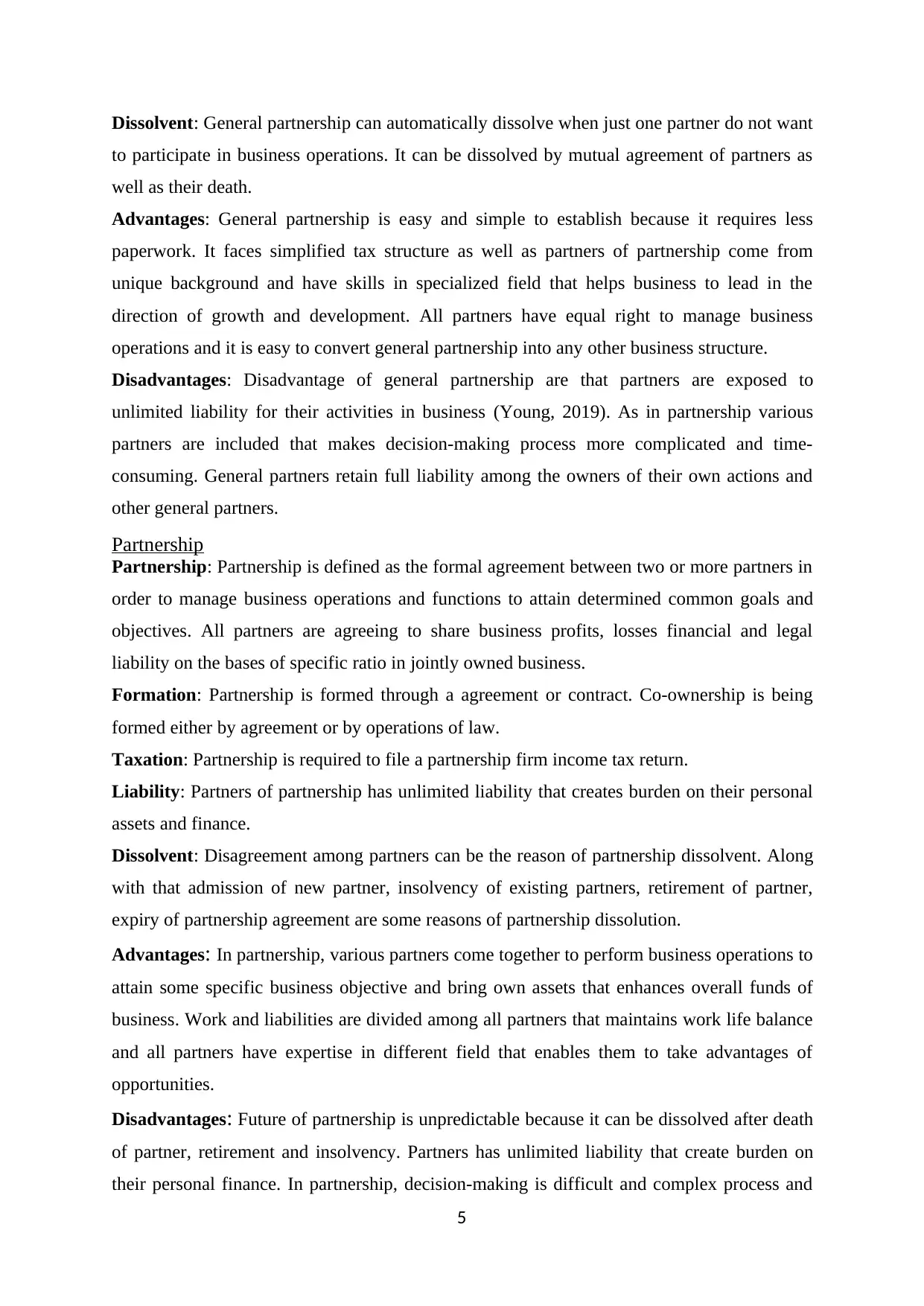
Dissolvent: General partnership can automatically dissolve when just one partner do not want
to participate in business operations. It can be dissolved by mutual agreement of partners as
well as their death.
Advantages: General partnership is easy and simple to establish because it requires less
paperwork. It faces simplified tax structure as well as partners of partnership come from
unique background and have skills in specialized field that helps business to lead in the
direction of growth and development. All partners have equal right to manage business
operations and it is easy to convert general partnership into any other business structure.
Disadvantages: Disadvantage of general partnership are that partners are exposed to
unlimited liability for their activities in business (Young, 2019). As in partnership various
partners are included that makes decision-making process more complicated and time-
consuming. General partners retain full liability among the owners of their own actions and
other general partners.
Partnership
Partnership: Partnership is defined as the formal agreement between two or more partners in
order to manage business operations and functions to attain determined common goals and
objectives. All partners are agreeing to share business profits, losses financial and legal
liability on the bases of specific ratio in jointly owned business.
Formation: Partnership is formed through a agreement or contract. Co-ownership is being
formed either by agreement or by operations of law.
Taxation: Partnership is required to file a partnership firm income tax return.
Liability: Partners of partnership has unlimited liability that creates burden on their personal
assets and finance.
Dissolvent: Disagreement among partners can be the reason of partnership dissolvent. Along
with that admission of new partner, insolvency of existing partners, retirement of partner,
expiry of partnership agreement are some reasons of partnership dissolution.
Advantages: In partnership, various partners come together to perform business operations to
attain some specific business objective and bring own assets that enhances overall funds of
business. Work and liabilities are divided among all partners that maintains work life balance
and all partners have expertise in different field that enables them to take advantages of
opportunities.
Disadvantages: Future of partnership is unpredictable because it can be dissolved after death
of partner, retirement and insolvency. Partners has unlimited liability that create burden on
their personal finance. In partnership, decision-making is difficult and complex process and
5
to participate in business operations. It can be dissolved by mutual agreement of partners as
well as their death.
Advantages: General partnership is easy and simple to establish because it requires less
paperwork. It faces simplified tax structure as well as partners of partnership come from
unique background and have skills in specialized field that helps business to lead in the
direction of growth and development. All partners have equal right to manage business
operations and it is easy to convert general partnership into any other business structure.
Disadvantages: Disadvantage of general partnership are that partners are exposed to
unlimited liability for their activities in business (Young, 2019). As in partnership various
partners are included that makes decision-making process more complicated and time-
consuming. General partners retain full liability among the owners of their own actions and
other general partners.
Partnership
Partnership: Partnership is defined as the formal agreement between two or more partners in
order to manage business operations and functions to attain determined common goals and
objectives. All partners are agreeing to share business profits, losses financial and legal
liability on the bases of specific ratio in jointly owned business.
Formation: Partnership is formed through a agreement or contract. Co-ownership is being
formed either by agreement or by operations of law.
Taxation: Partnership is required to file a partnership firm income tax return.
Liability: Partners of partnership has unlimited liability that creates burden on their personal
assets and finance.
Dissolvent: Disagreement among partners can be the reason of partnership dissolvent. Along
with that admission of new partner, insolvency of existing partners, retirement of partner,
expiry of partnership agreement are some reasons of partnership dissolution.
Advantages: In partnership, various partners come together to perform business operations to
attain some specific business objective and bring own assets that enhances overall funds of
business. Work and liabilities are divided among all partners that maintains work life balance
and all partners have expertise in different field that enables them to take advantages of
opportunities.
Disadvantages: Future of partnership is unpredictable because it can be dissolved after death
of partner, retirement and insolvency. Partners has unlimited liability that create burden on
their personal finance. In partnership, decision-making is difficult and complex process and
5
⊘ This is a preview!⊘
Do you want full access?
Subscribe today to unlock all pages.

Trusted by 1+ million students worldwide
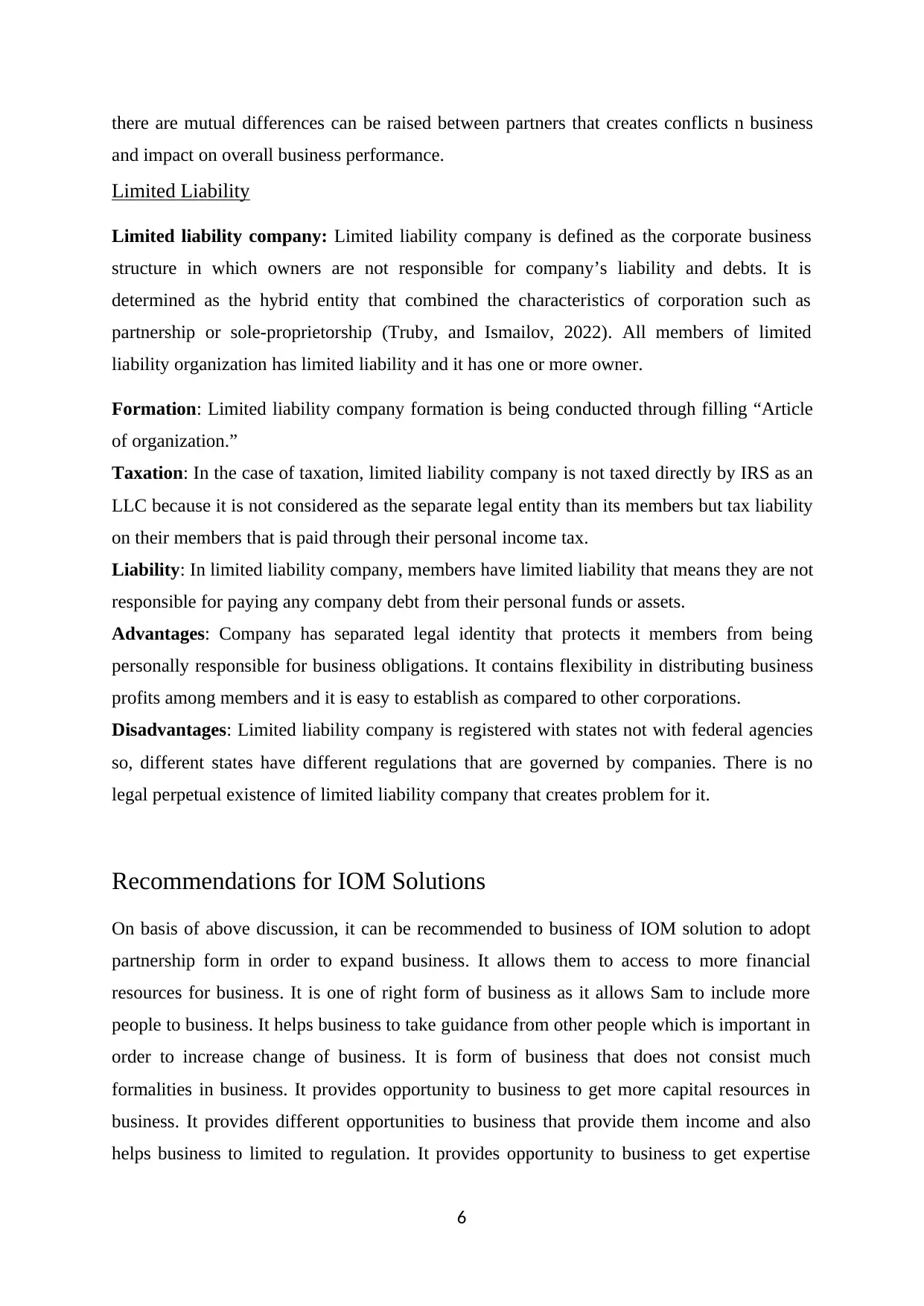
there are mutual differences can be raised between partners that creates conflicts n business
and impact on overall business performance.
Limited Liability
Limited liability company: Limited liability company is defined as the corporate business
structure in which owners are not responsible for company’s liability and debts. It is
determined as the hybrid entity that combined the characteristics of corporation such as
partnership or sole-proprietorship (Truby, and Ismailov, 2022). All members of limited
liability organization has limited liability and it has one or more owner.
Formation: Limited liability company formation is being conducted through filling “Article
of organization.”
Taxation: In the case of taxation, limited liability company is not taxed directly by IRS as an
LLC because it is not considered as the separate legal entity than its members but tax liability
on their members that is paid through their personal income tax.
Liability: In limited liability company, members have limited liability that means they are not
responsible for paying any company debt from their personal funds or assets.
Advantages: Company has separated legal identity that protects it members from being
personally responsible for business obligations. It contains flexibility in distributing business
profits among members and it is easy to establish as compared to other corporations.
Disadvantages: Limited liability company is registered with states not with federal agencies
so, different states have different regulations that are governed by companies. There is no
legal perpetual existence of limited liability company that creates problem for it.
Recommendations for IOM Solutions
On basis of above discussion, it can be recommended to business of IOM solution to adopt
partnership form in order to expand business. It allows them to access to more financial
resources for business. It is one of right form of business as it allows Sam to include more
people to business. It helps business to take guidance from other people which is important in
order to increase change of business. It is form of business that does not consist much
formalities in business. It provides opportunity to business to get more capital resources in
business. It provides different opportunities to business that provide them income and also
helps business to limited to regulation. It provides opportunity to business to get expertise
6
and impact on overall business performance.
Limited Liability
Limited liability company: Limited liability company is defined as the corporate business
structure in which owners are not responsible for company’s liability and debts. It is
determined as the hybrid entity that combined the characteristics of corporation such as
partnership or sole-proprietorship (Truby, and Ismailov, 2022). All members of limited
liability organization has limited liability and it has one or more owner.
Formation: Limited liability company formation is being conducted through filling “Article
of organization.”
Taxation: In the case of taxation, limited liability company is not taxed directly by IRS as an
LLC because it is not considered as the separate legal entity than its members but tax liability
on their members that is paid through their personal income tax.
Liability: In limited liability company, members have limited liability that means they are not
responsible for paying any company debt from their personal funds or assets.
Advantages: Company has separated legal identity that protects it members from being
personally responsible for business obligations. It contains flexibility in distributing business
profits among members and it is easy to establish as compared to other corporations.
Disadvantages: Limited liability company is registered with states not with federal agencies
so, different states have different regulations that are governed by companies. There is no
legal perpetual existence of limited liability company that creates problem for it.
Recommendations for IOM Solutions
On basis of above discussion, it can be recommended to business of IOM solution to adopt
partnership form in order to expand business. It allows them to access to more financial
resources for business. It is one of right form of business as it allows Sam to include more
people to business. It helps business to take guidance from other people which is important in
order to increase change of business. It is form of business that does not consist much
formalities in business. It provides opportunity to business to get more capital resources in
business. It provides different opportunities to business that provide them income and also
helps business to limited to regulation. It provides opportunity to business to get expertise
6
Paraphrase This Document
Need a fresh take? Get an instant paraphrase of this document with our AI Paraphraser
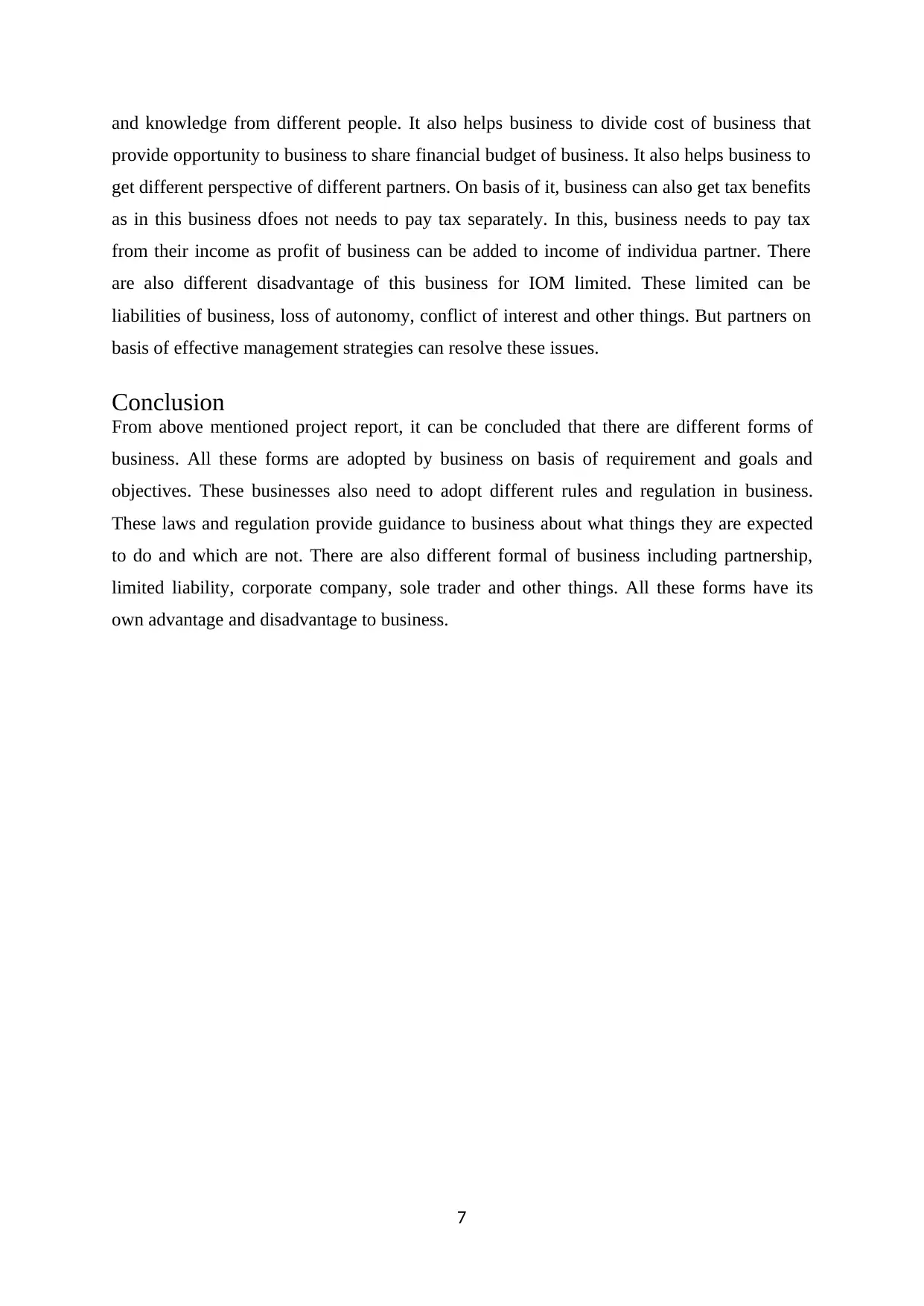
and knowledge from different people. It also helps business to divide cost of business that
provide opportunity to business to share financial budget of business. It also helps business to
get different perspective of different partners. On basis of it, business can also get tax benefits
as in this business dfoes not needs to pay tax separately. In this, business needs to pay tax
from their income as profit of business can be added to income of individua partner. There
are also different disadvantage of this business for IOM limited. These limited can be
liabilities of business, loss of autonomy, conflict of interest and other things. But partners on
basis of effective management strategies can resolve these issues.
Conclusion
From above mentioned project report, it can be concluded that there are different forms of
business. All these forms are adopted by business on basis of requirement and goals and
objectives. These businesses also need to adopt different rules and regulation in business.
These laws and regulation provide guidance to business about what things they are expected
to do and which are not. There are also different formal of business including partnership,
limited liability, corporate company, sole trader and other things. All these forms have its
own advantage and disadvantage to business.
7
provide opportunity to business to share financial budget of business. It also helps business to
get different perspective of different partners. On basis of it, business can also get tax benefits
as in this business dfoes not needs to pay tax separately. In this, business needs to pay tax
from their income as profit of business can be added to income of individua partner. There
are also different disadvantage of this business for IOM limited. These limited can be
liabilities of business, loss of autonomy, conflict of interest and other things. But partners on
basis of effective management strategies can resolve these issues.
Conclusion
From above mentioned project report, it can be concluded that there are different forms of
business. All these forms are adopted by business on basis of requirement and goals and
objectives. These businesses also need to adopt different rules and regulation in business.
These laws and regulation provide guidance to business about what things they are expected
to do and which are not. There are also different formal of business including partnership,
limited liability, corporate company, sole trader and other things. All these forms have its
own advantage and disadvantage to business.
7
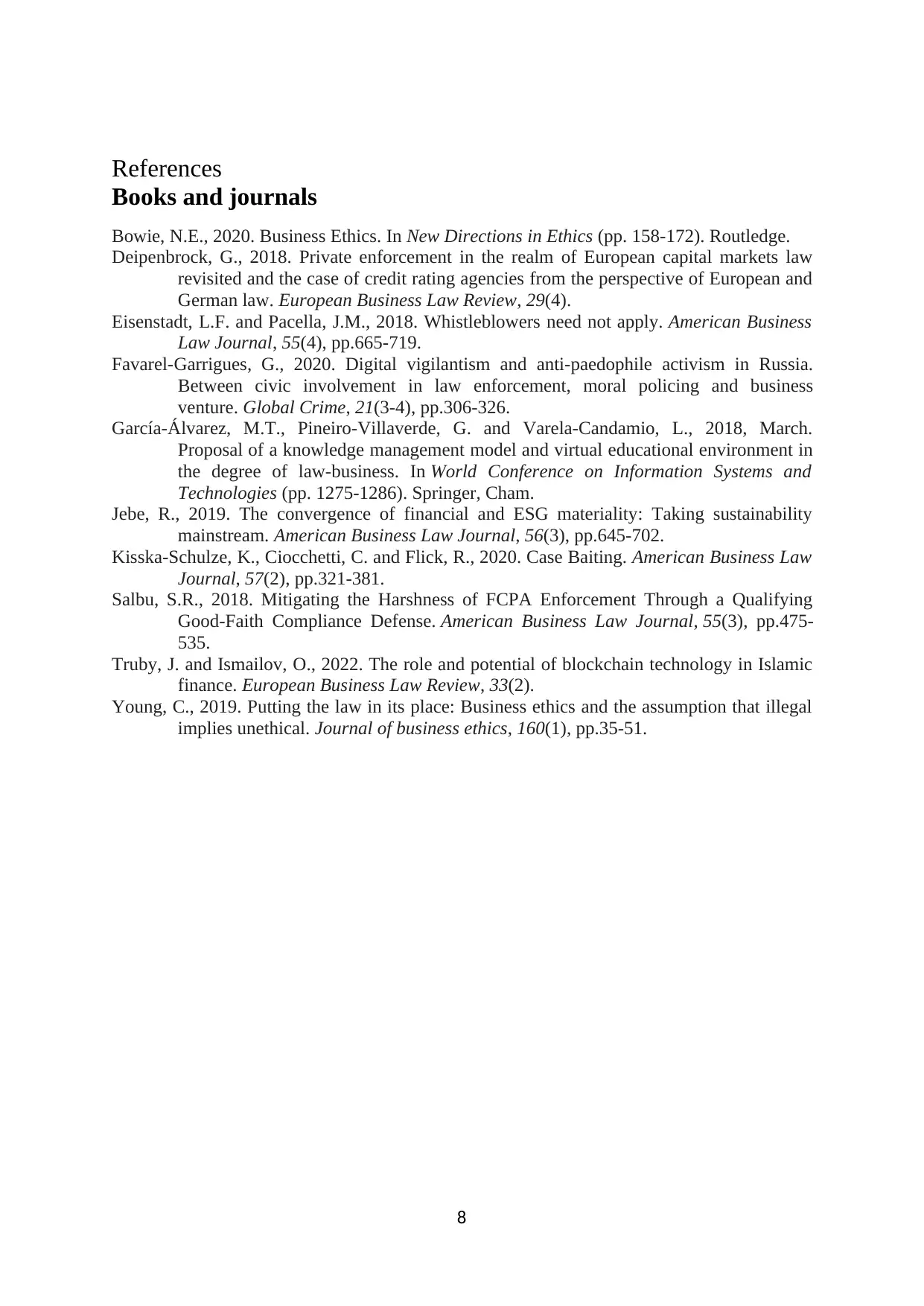
References
Books and journals
Bowie, N.E., 2020. Business Ethics. In New Directions in Ethics (pp. 158-172). Routledge.
Deipenbrock, G., 2018. Private enforcement in the realm of European capital markets law
revisited and the case of credit rating agencies from the perspective of European and
German law. European Business Law Review, 29(4).
Eisenstadt, L.F. and Pacella, J.M., 2018. Whistleblowers need not apply. American Business
Law Journal, 55(4), pp.665-719.
Favarel-Garrigues, G., 2020. Digital vigilantism and anti-paedophile activism in Russia.
Between civic involvement in law enforcement, moral policing and business
venture. Global Crime, 21(3-4), pp.306-326.
García-Álvarez, M.T., Pineiro-Villaverde, G. and Varela-Candamio, L., 2018, March.
Proposal of a knowledge management model and virtual educational environment in
the degree of law-business. In World Conference on Information Systems and
Technologies (pp. 1275-1286). Springer, Cham.
Jebe, R., 2019. The convergence of financial and ESG materiality: Taking sustainability
mainstream. American Business Law Journal, 56(3), pp.645-702.
Kisska‐Schulze, K., Ciocchetti, C. and Flick, R., 2020. Case Baiting. American Business Law
Journal, 57(2), pp.321-381.
Salbu, S.R., 2018. Mitigating the Harshness of FCPA Enforcement Through a Qualifying
Good‐Faith Compliance Defense. American Business Law Journal, 55(3), pp.475-
535.
Truby, J. and Ismailov, O., 2022. The role and potential of blockchain technology in Islamic
finance. European Business Law Review, 33(2).
Young, C., 2019. Putting the law in its place: Business ethics and the assumption that illegal
implies unethical. Journal of business ethics, 160(1), pp.35-51.
8
Books and journals
Bowie, N.E., 2020. Business Ethics. In New Directions in Ethics (pp. 158-172). Routledge.
Deipenbrock, G., 2018. Private enforcement in the realm of European capital markets law
revisited and the case of credit rating agencies from the perspective of European and
German law. European Business Law Review, 29(4).
Eisenstadt, L.F. and Pacella, J.M., 2018. Whistleblowers need not apply. American Business
Law Journal, 55(4), pp.665-719.
Favarel-Garrigues, G., 2020. Digital vigilantism and anti-paedophile activism in Russia.
Between civic involvement in law enforcement, moral policing and business
venture. Global Crime, 21(3-4), pp.306-326.
García-Álvarez, M.T., Pineiro-Villaverde, G. and Varela-Candamio, L., 2018, March.
Proposal of a knowledge management model and virtual educational environment in
the degree of law-business. In World Conference on Information Systems and
Technologies (pp. 1275-1286). Springer, Cham.
Jebe, R., 2019. The convergence of financial and ESG materiality: Taking sustainability
mainstream. American Business Law Journal, 56(3), pp.645-702.
Kisska‐Schulze, K., Ciocchetti, C. and Flick, R., 2020. Case Baiting. American Business Law
Journal, 57(2), pp.321-381.
Salbu, S.R., 2018. Mitigating the Harshness of FCPA Enforcement Through a Qualifying
Good‐Faith Compliance Defense. American Business Law Journal, 55(3), pp.475-
535.
Truby, J. and Ismailov, O., 2022. The role and potential of blockchain technology in Islamic
finance. European Business Law Review, 33(2).
Young, C., 2019. Putting the law in its place: Business ethics and the assumption that illegal
implies unethical. Journal of business ethics, 160(1), pp.35-51.
8
⊘ This is a preview!⊘
Do you want full access?
Subscribe today to unlock all pages.

Trusted by 1+ million students worldwide
1 out of 9
Related Documents
Your All-in-One AI-Powered Toolkit for Academic Success.
+13062052269
info@desklib.com
Available 24*7 on WhatsApp / Email
![[object Object]](/_next/static/media/star-bottom.7253800d.svg)
Unlock your academic potential
Copyright © 2020–2025 A2Z Services. All Rights Reserved. Developed and managed by ZUCOL.
